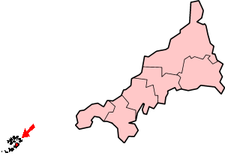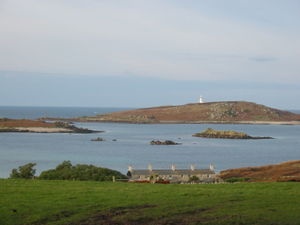Isles of Scilly
2007 Schools Wikipedia Selection. Related subjects: Geography of Great Britain
The Isles of Scilly ( Cornish: Ynysek Syllan) form an archipelago of islands off the southwesternmost tip of England. Traditionally part of Cornwall, they now have their own local government. The islands are designated the Isles of Scilly Area of Outstanding Natural Beauty. Scilly was also the name of one of ten ancient administrative shires of Cornwall - see " Hundreds of Cornwall".
The county flower of the Isles of Scilly is Thrift.
The islands are correctly referred to as the Isles of Scilly, or simply as Scilly; the terms "Scillies" and "Scilly Isles" are considered incorrect by locals.
Geography
The Isles of Scilly form an archipelago of six inhabited islands and numerous other small rocky islets (around 140 in total) lying 28 miles (45 km) off Land's End – the most southwesterly point of Great Britain. The six inhabited islands are St Mary's (2001 census population: 1,666), Tresco (180), St Martin's (142), St Agnes (70), Bryher (92) and Gugh (3); the total population was 2,153. Until 1855, Samson was also inhabited. There are many smaller uninhabited islands and rocky islets.
The islands' position produces a place of great contrast – the ameliorating effect of the sea means they rarely have frost or snow, which allows local farmers to grow flowers well ahead of those on the island of Britain. The largest agricultural product is cut flowers, mostly daffodils. Exposure to Atlantic winds means that spectacular winter gales lash the islands from time to time.
This is reflected in the landscape, most clearly seen on Tresco where the lush sub-tropical Abbey Gardens on the sheltered southern end of the island contrast with the low heather and bare rock sculpted by the wind on the exposed northern end.
It was featured on the TV programme Seven Natural Wonders as one of the wonders of South west England.
History
Scilly has been inhabited since Stone Age times and its history has been one of subsistence living until the 20th century with people living off the land and the sea. Farming and fishing continue today, but the main industry now is tourism.
The islands may correspond to the Cassiterides (" Tin Isles") visited by the Phoenicians and mentioned by the Greeks.
It is likely that until relatively recently the Isles were much larger with many of them joined into one island and that the land has subsided. Evidence for this includes:
- A description in Roman times describes Scilly as "Scillonia insula" in the singular, as if there was an island much bigger than any of the others.
- Remains of a prehistoric farm have been found on Nornour, which is now a small rocky skerry far too small for farming.
- At certain low tides the sea becomes shallow enough for people to walk between some of the islands. This is possibly one of the sources for stories of drowned lands, e.g., Lyonesse.
- Ancient field walls are visible below the high tide line off some of the islands (e.g. Samson).
It is not known at exactly which point the islands stopped speaking Cornish, but it seems to have gone into decline during the Middle Ages, and lost the language before parts of Penwith. The islands thus appeared to have lost the old Celtic language before parts of the mainland, in contrast to the situation of Irish or Scottish Gaelic.
During the English Civil War, the isles were a stronghold for the Royalists. It was during this period that the Three Hundred and Thirty Five Years' War started between the isles and the Netherlands. In June 1651, the isles were captured from the Royalists by Admiral Robert Blake for the Parliamentarians.
Scilly is famous for its danger to shipping and its many shipwrecks. The wreck of Sir Cloudesley Shovell's ship HMS Association in 1707 off the Isles of Scilly due to inaccuracies in navigation led to the development of the method of lunar distances, and to the invention of the chronometer by John Harrison, the first reliable methods of determining longitude at sea.
The sea has always played a huge part in Scillonian history but it was in the 19th century that Scilly had its maritime heyday. Beaches which are now enjoyed by sunbathers were then factories for shipbuilding; the harbours now full of pleasure boats were once packed with local and visiting fishing and trading boats.
One continuing legacy of the isles' past is gig racing, wherein fast rowing boats ("gigs") with crews of six (or in one case, seven) race between the main islands. Gig racing has been said to derive from the race to collect salvage from shipwrecks on the rocks around Scilly, but the race was actually to deliver a pilot onto incoming vessels, to guide them through the hazardous reefs and shallows. (The boats are correctly termed "pilot gigs".)
Former Prime Minister Harold Wilson regularly holidayed on the Isles and eventually bought a cottage there as a holiday home. He is buried on St Mary's. His widow Mary Wilson is still a frequent visitor.
Flag
There are primarily two flags used to represent Scilly:
- The flag of the Council of the Isles of Scilly, which incorporates their logo.
- The unofficial Scillonian Cross, voted for by readers of Scilly News .
An adapted version of the old Board of Ordnance flag has also been used, after it was left behind when munitions were removed from the isles. The Cornish Ensign has also been used.
Economy
The principal current economic activity is tourism. The tourist season has been extended into October when many birdwatchers (or birders) arrive. Because of its position, Scilly is the first landing for many migrant birds, including extreme rarities from North America and Siberia.
The main transport links with the mainland are currently:
- Helicopter services between Penzance Heliport and St Mary's and Tresco ( British International)
- Aeroplane services to St Mary's from various UK airports (Land's End, Newquay, Exeter, Bristol and Southampton - Skybus operated by the Isles of Scilly Steamship Group)
- By sea on the Scillonian III, sailing from Penzance harbour ( Isles of Scilly Travel part of the Isles of Scilly Steamship Group)
The freehold of the islands is the property of the British Crown (except for Hugh Town on St Mary's, which was sold to the inhabitants in 1949). The crown estate in the islands is administered by the Duchy of Cornwall. The duchy also holds 3,921 acres as duchy property, part of the duchy's landholding.
The sea around Scilly is very clear and there is much rocky seabed, and scuba diving is popular there.
Area of Outstanding Natural Beauty
In 1975, the islands were designated as an Area of Outstanding Natural Beauty. The designation covers the entire archipelago, including the uninhabited islands and rocks, and is the smallest such area in the UK. The islands of Annet and Samson have large terneries and the islands are well populated by seals. The Isles of Scilly are the only British haunt of the White-toothed Shrew.
The islands are famous amongst birdwatchers, especially twitchers for their almost magnetic ability to attract rare birds from all corners of the globe. The peak time of year for this is generally in October when it is not unusual for several of the rarest birds in Europe to share this archipelago. One reason for the success of these islands in producing rarities is the extensive coverage these islands get from birdwatchers, but island archipelagos are favoured by rare birds which like to make landfall and eat before continuing their journeys and often arrive on far flung islands first.
Football (Soccer)
The Isles of Scilly feature what is reportedly the smallest national football(soccer) league in the world. The league's two clubs, Woolpack Wanderers and Garrison Gunners, play each other around twenty times a season and compete for two cups as well as the league title. The two share a ground, Garrison Field, but travel to the mainland for part of the year to play other non-professional clubs.


